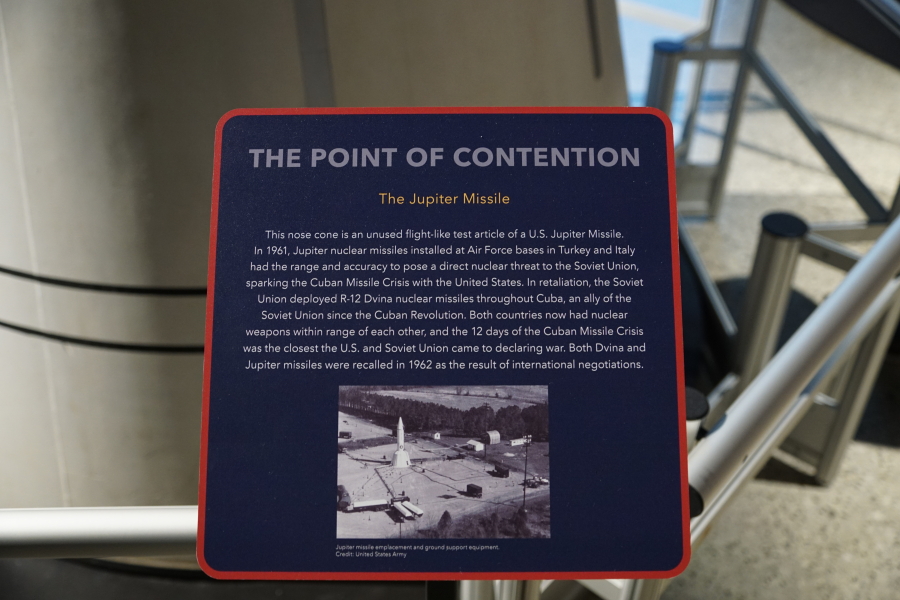| Prev |
heroicrelics.org Apollo: When We Went to the Moon Site Index Apollo: When We Went to the Moon Gallery |
Next |
dscd2984.jpg
The sign accompanying the Jupiter nose cone.
It reads
The Point of Contention
The Jupiter Missile
This nose cone is an unused flight-like test article of a U.S. Jupiter Missile. In 1961, Jupiter nuclear missiles installed at Air Force bases in Turkey and Italy had the range and accuracy to pose a direct nuclear threat to the Soviet Union, sparking the Cuban Missile Crisis with the United States. In retaliation, the Soviet Union deployed R-12 Dvina nuclear missiles throughout Cuba, an ally of the Soviet Union since the Cuban Revolution. Both countries now had nuclear weapons in range of each other, and the 12 days of the Cuban Missile Crisis was the closest the U.S. and Soviet Union came to declaring war. Both Dvina and Jupiter missiles were recalled in 1962 as a result of the international negotiations.
Like many Americans, I was brought up believing that the evil Soviet Union threatened freedom and democracy by suddenly deploying missiles to Cuba, and the world was saved only by the courage and resolve of John F. Kennedy, who along with his trusted advisors bravely stood up to this threat and forced the Soviets to remove the missiles.
I later learned that the Cuban Missile Crisis was actually precipitated by American actions.
The Other Missiles of October: Eisenhower, Kennedy, and the Jupiters, 1957-1963 is a fascinating book about the decision to place Jupiters in Italy and Turkey. From the time the initial decision to place these missiles became known, the Soviet Union protested, through both official and personal channels. The Soviets often pointed out that it would be the equivalent of them deploying missiles to Cuba.
It was during the Eisenhower administration when discussions were initiated to place Jupiters in Italy and Turkey. John F. Kennedy was elected before the missiles were actually deployed, and when he took office, many members of his own administration advised against deploying these missiles (which were largely obsolete by that by the time). Nevertheless, JFK proceeded with the deployment plans, mostly to avoid losing face, especially after the June 1961 summit in Vienna during which Khrushchev renewed Soviet protestations to the Jupiters. All of the Italian Jupiters were operational by July 1961 and the first Turkish Jupiters were operational in November 1961.
The Soviets, with the American Jupiters on their doorsteps, began deploying missiles to Cuba, essentially doing to America what America had done to them. Upon discovery of the Cuban missile emplacements, Kennedy reacted and thus began the Cuban Missile Crisis. Contrary to the popular myth surrounding JFK's handling of the matter, he ultimately did offer an explicit quid pro quo, the removal of Jupiters for the removal of the Cuban missiles. Again concerned about his image, he demanded that the Soviets not publicly mention the trade. The Soviets agreed to remove their missiles on October 28, but the U.S. did not withdraw the Jupiters until April 1963.
To further minimize the perception of a quid pro quo, the U.S. publicized the deployment of Polaris-equipped submarines to the Mediterranean in March and April 1963. One of the boomers visited Turkey, coinciding with visits from high-ranking American military officers. The matter was framed as the replacement of a weapon system, rather than a withdrawal.
The Cuban Missile Crisis was entirely predictable and preventable. Kennedy became, essentially, the "hero" of a crisis of his own making.

| Time picture taken | Sat Jun 22 12:47:12 2019 |
| Location picture taken |
Apollo: When We Went to the Moon Exhibit Space Hall "Old" Museum U.S. Space & Rocket Center Huntsville, AL |
| Prev | Apollo: When We Went to the Moon Gallery | Next |